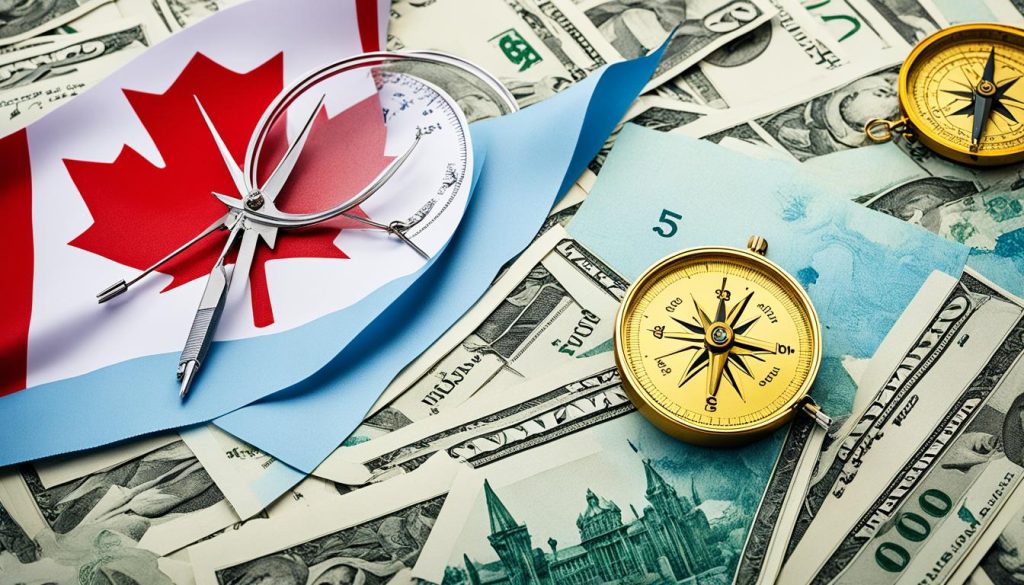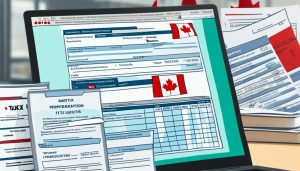Believe it or not, a staggering 1 in 4 Canadians have less than $1,000 saved for their golden years. This alarming statistic highlights the pressing need for Canadians to understand how much they truly require to retire comfortably. Whether you dream of an early retirement at 60 with $500,000 or aspire to reach the millionaire milestone by 65, navigating the complexities of retirement planning is crucial. In this comprehensive guide, we’ll explore the various factors that determine your retirement savings needs and provide practical strategies to ensure you’re on track to achieve your financial goals.
According to the first source, there is no one-size-fits-all answer to how much you need to retire in Canada, as it depends on various factors such as when you want to retire, where you want to live, and what your expenses will be. The key is to understand your retirement planning needs and calculate your monthly retirement income. The second source highlights 10 important questions to answer to determine how much you need to retire, including when you started saving, your retirement timeline, life expectancy, retirement lifestyle plans, pension details, investment returns, assets, withdrawal strategies, legacy goals, and review frequency. The third source from the Financial Consumer Agency of Canada explains that the amount needed for retirement depends on your age at retirement, hobbies, travel plans, post-retirement work, family obligations, and debt. It also emphasizes the importance of comparing current and expected retirement spending, deciding on a retirement timeline, and understanding how inflation can impact your savings.
Understanding Retirement Planning Needs
Crafting a successful retirement plan in Canada requires a deep understanding of your personal goals and circumstances. Three crucial factors to consider are when you want to retire, where you would like to live in retirement, and what your expenses will be.
1. When Do You Want to Retire?
The timing of your retirement can significantly impact how much you need to save for your golden years. Retiring earlier means your savings will need to last longer, potentially requiring a larger nest egg than someone who plans to retire at the traditional age. It’s essential to assess your desired retirement timeline and the financial implications it may have on your retirement planning canada.
2. Where Would You Like to Live in Retirement?
Where you choose to live during your retirement can also affect your overall expenses. Costs may be higher or lower depending on the location, whether it’s staying in your current city, moving to a different province, or even considering early retirement in canada. Carefully evaluating the retirement costs in canada associated with your preferred retirement destination is crucial for accurate planning.
3. What Will Your Expenses Be?
Estimating your retirement expenses is a critical step in determining how much you need to save. As a general rule of thumb, you may need between 70-80% of your current income to maintain your desired lifestyle in retirement. However, it’s essential to factor in new costs, such as increased healthcare spending, that may arise as you age. By understanding your expected retirement age canada and anticipated expenses, you can better calculate the necessary savings to support your retirement goals.
Retirement planning in Canada is a highly personalized endeavor, as individual goals and circumstances can vary greatly even among those with similar profiles. By carefully considering these key factors, you can develop a comprehensive retirement plan that aligns with your unique needs and aspirations.
Calculating Your Monthly Retirement Income
For most retirement income canada and canadian retirement income in Canada, the sources come from a combination of personal savings, government plans like the canadian pension plans, and workplace pensions or retirement savings. Understanding the potential sources and amounts of your retirement income will help you determine if your savings are adequate to support your desired lifestyle.
It’s important to review your various retirement income sources, such as registered accounts, TFSAs, and other assets, to get a comprehensive understanding of your monthly retirement income canada. This will provide you with a clear picture of your financial resources and whether they align with your retirement goals.
It’s worth noting that public pensions like Old Age Security (OAS) and the Canada Pension Plan (CPP) are indexed to inflation, helping to protect their value over time. However, not all employer pensions offer the same level of protection, which is an important factor to consider when planning your canadian retirement income.

Factors Influencing Your Retirement Savings
Your retirement savings in Canada can be influenced by several key factors, including when you started saving, whether you have a workplace pension plans canada, and the assets you’ve accumulated over time.
1. When Did You Start Saving for Retirement?
The earlier you begin rrsp planning and contributing to your retirement savings, the more time your money has to grow through the power of compound interest. A 25-year-old who saves 8-10% of their income may need to contribute less each month compared to a 45-year-old who needs to save 25% of their income to reach the same retirement goals.
2. Do You Have a Workplace Pension?
The presence of a retirement savings canada workplace pension can significantly impact your overall retirement savings needs. Employer-sponsored pensions can provide a reliable source of retirement income, potentially reducing the amount you need to save on your own.
3. What Assets Do You Have?
In addition to your registered savings accounts, such as RRSPs and TFSAs, your non-registered assets, including real estate, investments, and other savings, should be factored into your retirement planning canada strategy. Understanding the full scope of your assets can help you develop a comprehensive plan for your retirement years.
How Much Do I Need to Retire Canada?
When it comes to determining how much you need to retire comfortably in Canada, the answer can vary greatly depending on your desired retirement planning canada lifestyle. According to financial experts, a modest retirement lifestyle may only require around 50% of your pre-retirement income, while an active retirement with travel and leisure activities could necessitate 70% or more.
1. Determine Your Desired Lifestyle
It’s essential to consider the type of retirement calculator canada lifestyle you envision for your golden years. Do you plan to maintain a relatively simple, low-cost lifestyle, or do you have aspirations for an active, adventurous retirement with more travel and leisure pursuits? Carefully evaluating your anticipated expenses, such as housing, healthcare, and leisure activities, will help you determine the appropriate retirement funds canada level of savings required to support your desired retirement lifestyle.
2. Consider Inflation and Its Impact
Another critical factor to consider when calculating your retirement investments canada retirement savings is the impact of inflation. The rising cost of living can significantly erode the purchasing power of your savings over time. For example, a retirement goal of $50,000 per year today may require as much as $81,900 in 20 years due to a 2.5% annual inflation rate. Incorporating realistic inflation projections into your retirement planning can ensure your savings keep pace with the increasing costs of goods and services.

Registered Savings Plans for Retirement
When planning for retirement in Canada, leveraging registered savings plans can be a highly effective strategy. Two of the most prominent options are the Registered Retirement Savings Plan (RRSP) and the Tax-Free Savings Account (TFSA), both of which offer unique benefits to help you maximize your rrsp planning and tax planning for retirement.
1. Maximizing Your RRSP Contributions
The RRSP is a powerful tax-deferred retirement savings account that allows you to contribute a portion of your pre-tax income and potentially reduce your annual tax bill. By maximizing your RRSP contributions, you can harness the power of compound growth and enjoy significant tax-deferred savings for your golden years. It’s important to understand how your workplace pension plan, if applicable, can impact your RRSP contribution room and strategize accordingly.
2. Tax-Free Savings Account (TFSA)
The TFSA is another valuable registered account that can complement your investment strategies for retirement. Unlike the RRSP, contributions to a TFSA are made with after-tax dollars, but the growth and withdrawals are tax-free. This makes the TFSA an excellent tool for building long-term wealth and generating tax-efficient retirement income.
When planning for a comfortable retirement, it’s crucial to work closely with a financial advisor who can help you navigate the intricacies of registered savings plans, optimize your contribution strategies, and ensure your overall rrsp planning and tax planning for retirement are aligned with your unique goals and circumstances.
Early Withdrawals and Their Consequences
When it comes to retirement planning in Canada, it’s crucial to understand the potential consequences of making early withdrawals from your registered retirement accounts, such as Registered Retirement Savings Plans (RRSPs). The retirement income in Canada that you’ve carefully built up over the years can be significantly impacted by these premature withdrawals.
The first source cautions against dipping into your RRSP prematurely, as this can result in taxes being paid on the withdrawal at your marginal rate. Additionally, you’ll lose the valuable contribution room and the potential for compound growth that these registered accounts offer. Instead, the source suggests building an emergency fund within a Tax-Free Savings Account (TFSA), as the contribution room in a TFSA can be restored in the following year, providing more flexibility and long-term benefits.
The second source reinforces these points, highlighting the “hidden costs” of early RRSP withdrawals. This includes the immediate tax implications, as well as the long-term impact on your retirement savings due to the loss of tax-deferred growth. The source emphasizes the importance of carefully considering the long-term implications before accessing these funds prematurely.
To ensure your retirement planning in Canada remains sustainable and aligned with your goals, the third source encourages exploring different scenarios and seeking professional advice. By working with a qualified financial advisor, you can gain a better understanding of the trade-offs and make informed decisions about the appropriate time to access your registered retirement savings.

Leaving a Legacy for Loved Ones
When planning for your retirement in Canada, it’s important to consider not only your own financial needs during the golden years but also the legacy you wish to leave for your loved ones. The retirement planning process should encompass your desires to provide for your family or support your favorite charities even after you’re gone.
According to one source, the decision to spend all your hard-earned retirement funds during your lifetime or set aside a portion to leave as a legacy can significantly impact your overall retirement savings and investment strategies. Careful consideration of your legacy goals is essential to ensure your retirement income and assets are allocated accordingly.
Another source suggests that life insurance can be an effective way to create a lasting legacy, allowing you to provide for your loved ones even after you’ve passed. Discussing your legacy aspirations with a financial advisor can help you align your retirement investments and estate planning to achieve your desired outcomes.
The third source emphasizes the importance of factoring your legacy goals into the overall retirement planning process. Your wishes to leave behind a financial gift or establish a charitable foundation can influence how you manage your retirement savings and assets, ultimately shaping the legacy you leave for future generations.
Reviewing and Adjusting Your Retirement Plan
Maintaining a retirement planning canada strategy that aligns with your evolving needs and goals is crucial for a secure financial future. The first step is to regularly review your retirement calculator canada and canadian retirement calculators to ensure your savings plan remains on track.
According to financial experts, it’s recommended to review your retirement planning canada at least every three years or whenever significant life events occur, such as a job change, marriage, or the birth of a child. This allows you to make well-informed decisions and adapt your strategy to changing circumstances.
Using canadian retirement calculators can be particularly helpful in evaluating your progress and identifying any necessary adjustments to your savings and investment strategies. These tools can provide valuable insights into the impact of factors like inflation, investment returns, and withdrawal rates on your long-term financial security.
Partnering with a qualified financial advisor can also be beneficial when reviewing and fine-tuning your retirement planning canada. They can offer guidance on maximizing the efficiency of your retirement calculator canada, helping you navigate the complexities of retirement planning and make informed decisions tailored to your unique needs and goals.
By regularly reviewing and adjusting your retirement plan, you can ensure it remains aligned with your evolving lifestyle, priorities, and financial circumstances, positioning you for a comfortable and fulfilling retirement.
Expert Advice for Canadian Retirement Planning
When it comes to retirement planning in Canada, seeking the guidance of a qualified financial advisor can be invaluable. These experts can help navigate the complex world of retirement income and Canadian retirement income, ensuring your savings plan is tailored to your unique needs and goals.
According to the first source, working with a retirement planning specialist can be beneficial at any stage of the process, as they can provide insights and strategies to tackle the various decisions you’ll face. These professionals can help you understand the factors influencing your retirement savings and income, and develop a comprehensive plan to help you achieve your desired lifestyle in retirement.
The second source echoes this sentiment, encouraging readers to find a financial advisor who can guide them through reviewing their retirement savings options and creating a cohesive plan. By collaborating with an expert, you can ensure your retirement planning aligns with your priorities and long-term objectives.
The third source reinforces the value of professional advice, noting that a qualified advisor can help you navigate the nuances of Canadian retirement income and other factors that may impact your savings. They can work with you to develop a tailored strategy that addresses your unique circumstances and helps you achieve your retirement goals.

Balancing Current Financial Priorities
As you plan for your retirement in Canada, it’s important to balance your current financial obligations with your long-term savings goals. The retirement planning canada process can be challenging when there are other pressing financial demands, such as a mortgage, car payments, or student loans. However, with careful budgeting and prioritization, you can find the right equilibrium between meeting your immediate needs and building a secure retirement nest egg.
Creating a Budget
The first step in balancing your retirement costs in canada and current financial priorities is to create a detailed budget. By tracking your income and expenses, you can identify areas where you can potentially cut back or reallocate funds towards your retirement planning canada. A well-crafted budget can help you determine how much you can realistically set aside for your long-term savings while still addressing your more immediate financial commitments.
The Government of Canada’s Budget Planner is a useful tool that can guide you through the budgeting process. By inputting your income, fixed expenses, and variable costs, the planner can help you create a personalized budget that accounts for your unique financial situation and allows you to direct funds towards your retirement costs in canada and other priorities.
Regularly reviewing and updating your budget can help you stay on track with your balancing current financial priorities and ensure that your retirement savings remain a top priority, even as your financial circumstances evolve over time.
Conclusion
In conclusion, determining how much you need to retire in Canada requires a comprehensive assessment of your unique circumstances, including your desired retirement timeline, lifestyle, expenses, income sources, and savings. By understanding the various factors that influence your retirement planning, you can develop a strategy to ensure you have the resources needed for a comfortable and fulfilling retirement.
Whether you’re just starting to save or are nearing the end of your career, seeking the guidance of a financial advisor can help you navigate the complexities of retirement savings and make well-informed decisions to achieve your goals. By carefully considering your retirement planning needs and exploring all available options, you can ensure you have the financial security to enjoy your golden years to the fullest.
Remember, there is no one-size-fits-all solution when it comes to how much you need to retire in Canada. By taking the time to assess your individual situation and plan accordingly, you can increase your chances of achieving a comfortable and worry-free retirement.
FAQ
1. How much do I need to retire in Canada?
There is no one-size-fits-all answer, as it depends on various factors such as when you want to retire, where you want to live, and what your expenses will be. The key is to understand your retirement planning needs and calculate your monthly retirement income.
2. What are the important questions to answer to determine how much I need to retire?
The important questions include when you started saving, your retirement timeline, life expectancy, retirement lifestyle plans, pension details, investment returns, assets, withdrawal strategies, legacy goals, and review frequency.
3. What factors can impact how much I need to retire in Canada?
The timing of your retirement, where you choose to live, your estimated retirement expenses, and the sources and amounts of your retirement income can all significantly impact how much you need to save.
4. How do I calculate my monthly retirement income?
Your retirement income can come from a combination of personal savings, government plans like the Canada Pension Plan and Old Age Security, and workplace pensions or retirement savings. Knowing the potential sources and amounts of your retirement income will help you determine if your savings are adequate.
5. How does the timing of when I start saving for retirement affect the amount I need to save?
The earlier you start saving for retirement, the less you’ll need to contribute each month to reach your goals, due to the power of compound interest. A 25-year-old may only need to save 8-10% of their income, while a 45-year-old may need to save 25%.
6. How much of my pre-retirement income do I need to maintain my desired lifestyle in retirement?
A modest retirement may only require 50% of your pre-retirement income, while an active retirement with travel could need 70% or more. The impact of inflation should also be considered when determining how much you’ll need.
7. What are the benefits of using registered savings plans like RRSPs and TFSAs for retirement?
RRSPs provide tax-deferred growth and a deduction in the current year, while TFSAs allow for tax-free withdrawals. Both can be effective tools for building your retirement savings.




